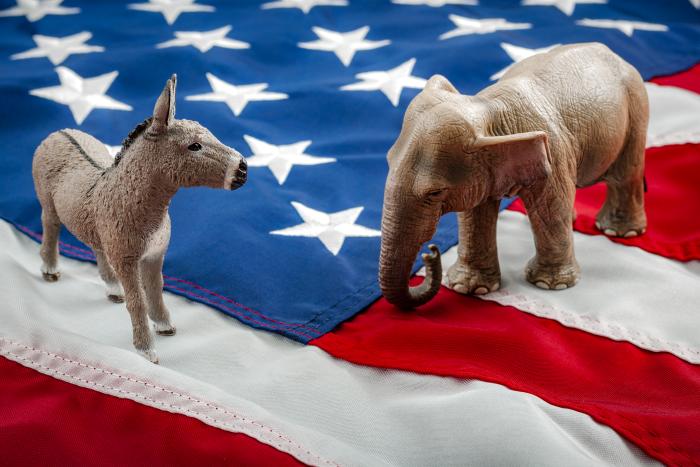- Politics, Institutions, and Public Opinion
Editor’s note: This essay is part of a series by the author about the state of American politics.
“Partisan ideological realignment has not eliminated national tides in elections. It has, however reduced their magnitude.”
—Alan I. Abramowitz
The 2006, 2010, and 2014 congressional elections were not kind to the preceding claim. As the political parties sorted, electoral patterns changed, but in a manner that accentuated rather than dampened the likelihood of national tides. The outcomes of presidential, congressional, and even state legislative elections now move in tandem in a way that was rare in the mid- to late twentieth century, not just in the so-called wave elections, but in elections more generally.
Political scientists commonly describe this development as nationalization. I write re-nationalization in the title of this essay because contemporary elections have returned to a pattern that was common in earlier periods of American history. When elections are nationalized, people vote for the party, not the person. Candidates of the party at different levels of government win and lose together. Their fate is collective.
Late twentieth-century political observers generally accepted this aphorism, credited to Democratic Speaker of the House Thomas P. “Tip” O’Neill of Massachusetts, who served in Congress from 1952 to 1987. In retrospect the period in which O’Neill served might be viewed as the golden age of the individual member of Congress, especially in the House. Party leadership was decentralized with committee and subcommittee chairs operating relatively independently of the party floor leadership. Members could pursue their policy interests relatively unconstrained by the positions of the leadership or party caucus. Party discipline was weak, enabling members to adopt whatever political coloring best suited their districts. Democratic representatives could take the conservative side of issues, especially in the South, and Republicans could take the liberal side, especially in the northeast. Bipartisanship and cross-party coalitions were not at all uncommon.
At the presidential level Democrats could fracture as the party did in 1968 or lose in landslides as in 1972 and 1984, but voters would split their tickets and return Democratic majorities to Congress. Members had learned to exploit every advantage their incumbency offered and to build personal reputations that insulated them from the national tides evident in the presidential voting.
Throughout this period, Republicans had talked about their goal of nationalizing congressional elections, by which they meant getting people to vote for congressional candidates at the same levels that they voted for Republican presidential candidates. This would have resulted in Republican congressional majorities in big presidential years like 1972 and 1980–84. But voters seemed content to behave in accord with “all politics is local”—until 1994.
The Republican wave in 1994 shocked not only pundits but even academic experts on congressional elections. Republican gains were expected, to be sure, but most analysts expected two dozen or so seats on the outside. Most of us dismissed as fanciful Newt Gingrich’s prediction that the Republicans would take the House. But when the electoral dust settled, Republicans had netted fifty-four seats in the House and ten in the Senate to take control of both chambers for the first time since the election of 1952. When political scientists looked back over the period, they saw that growing nationalization had been underway for some time, but the signals had not been recognized.
Political scientist Walter Dean Burnham first pointed out that the declining correlation between presidential and congressional voting lessened the responsiveness of the political system. That is, as incumbents insulated themselves from electoral tides, the capacity of voters to hold the government as a whole accountable weakened. In contrast to elections in the late nineteenth century, presidential coattails had all but disappeared by the 1980s. Thus, fewer members of Congress felt indebted to the president for their elections.
Moreover, midterm seat losses in the modern era were pale reflections of those that occurred in the late nineteenth century. With most of their fates independent of his, members of the president’s party had less incentive to help an administration of their party, especially if it entailed any political cost to them. The unproductive relationship between President Jimmy Carter and the large Democratic majorities in Congress epitomized this state of affairs.
The disassociation between the presidential and congressional electoral arenas probably was both a cause and a consequence of the rapid growth in the advantage of incumbency in the second half of the twentieth century. This terminology referred to a “personal vote,” the additional support that incumbents could expect compared to what any generic non-incumbent member of their party running in their district in a given election could expect.
Scholars identified numerous advantages of incumbency: the growth in nonpartisan, non-ideological constituency service as the federal role in society and the economy expanded, the decline in high-quality challengers as local party organizations withered and became too weak to recruit and fund strong candidates, and, later, the widening campaign funding advantage incumbents enjoyed. Various measures of the incumbency advantage appear in the literature, but the one with the firmest statistical basis is that of Andrew Gelman and Gary King. From the mid-1950s to the late 1990s the estimated advantage fluctuated between 6 and 12 percentage points until beginning a downward trend in the new century.
You may continue reading this essay here.
















